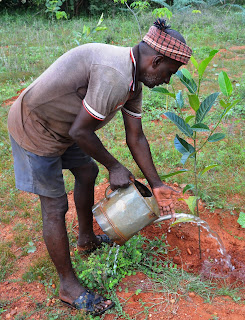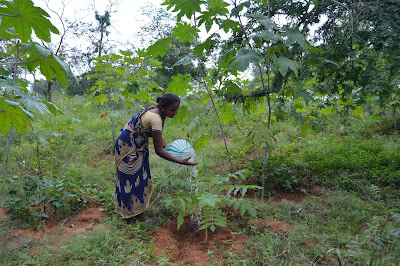 |
| Pedal pump,India Mark II, India Mark III and sanitary toilets for demo in SEVAI RTC. |
SEVAI Rural Technology centre (RTC),as supported by Foundation Hirzel and OFI, in Sirugamani trains villagers in Hand pump and treadle pump technology. RTC
has erected India Mark II, India Mark III, Pedal Pump, TARA Pump, and various cost
effective cost effective toilet live models these benefit rural populations. K.Devendran,
the coordinator of RTC made enlightened students those visited RTC on 17,Dec
2019 and said, “Hand pumps are manually operated pumps; they use human power and mechanical advantage to move
fluids or air from one place to another. Hand pumps are
commonly used in developing countries for both community supply and self-supply
of water and can be installed on boreholes. There are several types of water hand pumps. When the piston moves downwards in hand pump, the foot valve closes to prevent back flow of water and
the piston valve opens to allowing the piston to move down through the water in
the cylinder. India mark II: This Hand Pump is widely used in rural areas it is
commonly called India Mark II Deep Well Hand Pumps. In this pump the connecting
rod and riser pipe will be of three meters long each. These pumps have to work
in rural areas, where infrastructure facility for maintenance is not available
it is necessary that these pumps are sturdy, reliable, trouble free and easy to
operate. The India Mark II is a human-powered pump designed to lift water from
a depth of fifty metres or less. The Mark II is world's most widely used water hand
pump. The pump is installed on top of a drilled well or borehole and these
pumps are easy to install, Easy
maintenance, Wear Resistant- better Abrasion for long life, Good machinability,
Excellent stain resistance and Cost Effective. India
Mark III Water Well Hand Pump; Development of the India
Mark III hand pump arose out of the community-level experiences of those who
produced, installed, and distributed the India Mark II pumps. The India Mark II
pump is one of the most widely used hand pumps around the world. But it is not
suited for village level operation and maintenance (VLOM).Because the Mark II
water well hand pump has a closed-top cylinder, every time the pump cylinder
components require maintenance or replacement, the riser main, pump rod, and
cylinder all have to be pulled out of the well. During development and
distribution of the India Mark II, experiences in the field and the laboratory
made the developers of that water well hand pump aware of the need for
communities to have the ability to maintain and repair their own water pumps
without relying on too much outside support. In addressing this issue, the
developers sought to research and design a hand pump that offered those
repairing them the ability to remove the piston and foot valve for maintenance
without removing of the riser main. The VLOM strategy appeared to be a
technological strategy. That is, the solution to villages and communities being
able to repair and maintain their own hand pumps was seen as a technological
problem that could be solved by the development of pumps that were VLOM-capable.
The VLOM idea restricted itself to the technical aspects by developing pumps
that could be, manufactured locally, thus ensuring availability of spare parts,
maintained by a village caretaker with minimal skills and lightweight tools,
sturdy under real-life field conditions, cost effective, Experience in the
field soon revealed, however, that there were more than just technological
reasons for water well hand pump break downs and a lack of maintenance.
Development of user-friendly water well hand pump technology that villagers,
with a minimum of training, could work on as hand pump mechanics ultimately led
to the need for deeper community involvement, responsibility, and ownership in
all aspects of water resource development”.The RTC Coordinator
further said, “Treadle Pump is a foot operated reciprocating type positive
displacement pump to draw water with open channel water delivery system from
surface water source like dug well, ponds, canal etc.A treadle pump is a
human-powered suction pump that
sits on top of a well and is used for irrigation. It is designed to lift water
from a depth of seven metres or less. The pumping is activated by stepping up
and down on treadle, which are levers, which drive pistons, creating cylinder
suction that draws groundwater to the surface. Treadle pumps free farmers from dependence on rain-fed irrigation and
helps farmers maximize return on their small plots of land. The treadle pump
can do most of the work of a motorized pump, but costs considerably less.
Treadle pumps are most commonly used by farmers on small plots of land,
typically about the size of an acre. They are also used in developing countries
and small villages. Compared to bucket irrigation, the treadle pump can greatly
increase the income that farmers generate from their land by increasing the
number of growing seasons, by expanding the types of crops that can be cultivated
and improving on the quality of grown crops”.-Govin


























